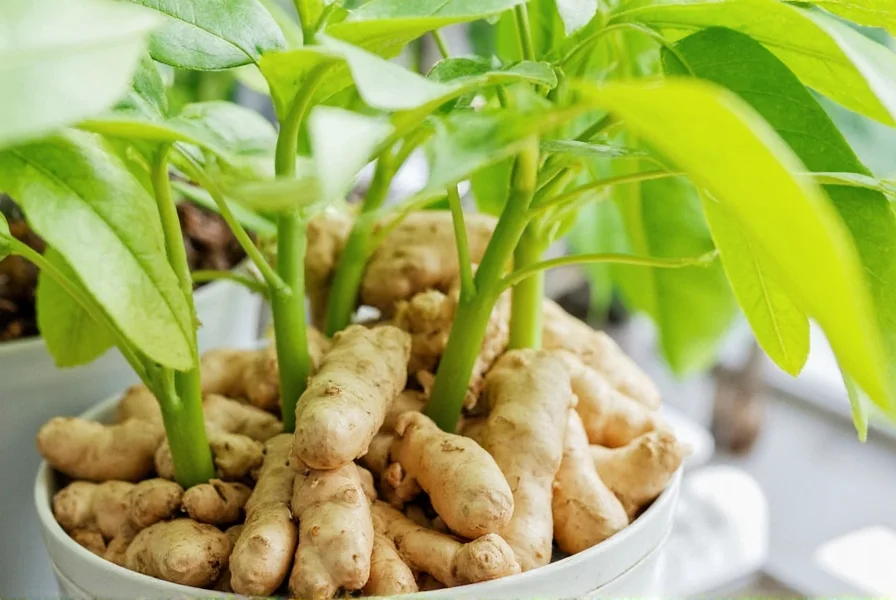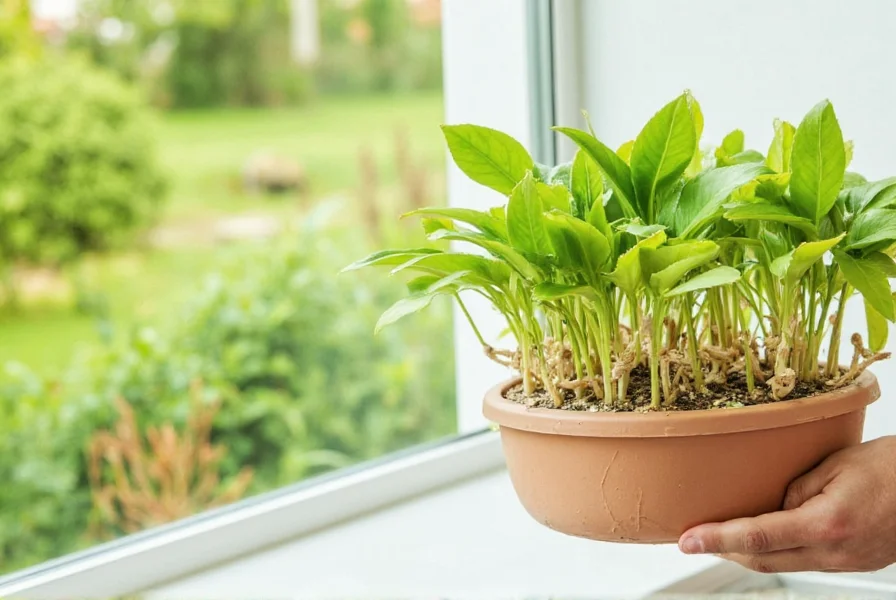Growing ginger root indoors offers a rewarding gardening experience that brings a tropical touch to your home while providing fresh, organic ginger for cooking and wellness. Unlike outdoor cultivation, indoor growing gives you complete control over environmental factors, making it possible to harvest ginger year-round regardless of your climate zone.
Why Grow Ginger Indoors?
Indoor ginger cultivation solves several challenges faced by outdoor growers. You're not limited by seasonal changes or unsuitable climates. Ginger thrives in warm, humid environments with filtered light—conditions easily replicated indoors. Plus, growing your own ginger ensures you have chemical-free rhizomes for culinary and medicinal uses, avoiding the waxed and treated store-bought varieties that often struggle to sprout.
Materials Needed for Indoor Ginger Growing
Before starting your indoor ginger project, gather these essential items:
| Item | Specific Requirements | Why It Matters |
|---|---|---|
| Ginger root | Organic, with visible eye buds | Non-organic roots are often treated to prevent sprouting |
| Container | 12-16 inches deep, with drainage holes | Ginger roots grow horizontally, needing width more than depth |
| Soil | Well-draining potting mix with high organic matter | Prevents root rot while retaining moisture |
| Watering can | Narrow spout for precise watering | Helps avoid overwatering the sensitive rhizomes |
Selecting the Right Ginger Root
The foundation of successful indoor ginger cultivation starts with selecting the proper root. Look for plump, firm ginger rhizomes with multiple visible growth buds (often called "eyes") that appear plump and slightly green. Organic ginger from the grocery store works best since conventional ginger is frequently treated with growth inhibitors. Soak your selected root in warm water for 2-4 hours before planting to stimulate sprouting—this simple step for growing ginger root in pots indoors significantly improves germination rates.

Planting Your Ginger Root
Fill your container with 2-3 inches of your prepared soil mix. Place the ginger root horizontally with the growth buds facing upward, then cover with 1-2 inches of additional soil. Ginger roots grow horizontally rather than downward, so proper orientation matters significantly when growing ginger root indoors. Water thoroughly after planting, then maintain consistent moisture without saturation. Position your container in a warm spot with indirect light—direct sunlight will scorch the delicate emerging shoots.
Optimal Growing Conditions
Ginger thrives in specific environmental conditions that mimic its native tropical habitat. Maintain temperatures between 70-85°F (21-29°C) year-round—avoid placing near heating vents or drafty windows. The ideal temperature for ginger plants indoors prevents dormancy while encouraging steady growth. Humidity levels should stay above 50%; consider using a humidity tray or small humidifier if your home air is dry. Provide bright, indirect light for 6-8 hours daily, rotating the pot weekly for even growth. East or north-facing windows typically offer perfect lighting for indoor ginger plant care.
Watering and Feeding Schedule
Consistent moisture ranks among the most critical factors for successful indoor ginger cultivation. Water when the top inch of soil feels dry, ensuring excess water drains freely from the container. Overwatering causes root rot, while underwatering stunts growth. During active growth (spring through fall), feed monthly with a balanced, organic liquid fertilizer diluted to half strength. Reduce watering slightly during winter months when growth naturally slows. Proper watering schedule for indoor ginger prevents common problems like yellowing leaves or stagnant growth.
Monitoring Growth and Development
Ginger follows a predictable growth pattern when cultivated indoors. Within 2-4 weeks, you'll notice small green shoots emerging from the soil. These will develop into cane-like stems with long, slender leaves. The plant focuses energy on establishing its root system during the first 3-4 months. After 5-6 months, the foliage becomes lush and full. The rhizomes continue developing underground throughout the growing season. Understanding how long it takes to grow ginger indoors helps set realistic expectations—most growers harvest after 8-10 months for optimal flavor and size.
Common Problems and Solutions
Even with proper care, indoor ginger growers may encounter these issues:
- Yellowing leaves: Usually indicates overwatering. Allow soil to dry slightly between waterings.
- Slow growth: Could signal insufficient light or nutrients. Move to a brighter location and apply diluted fertilizer.
- Mold on soil surface: Results from excessive humidity or poor air circulation. Improve ventilation and reduce surface moisture.
- No sprouting: The root may be too old or treated. Always use organic ginger and soak before planting.
Addressing these common problems growing ginger indoors promptly prevents minor issues from becoming plant-threatening conditions.
Harvesting Your Indoor Ginger
You can harvest ginger at different stages depending on your needs. For young, tender "spring ginger" with thin skin, carefully dig around the edges of the pot after 4-5 months. For mature rhizomes with full flavor and thicker skin, wait 8-10 months. To harvest without killing the plant, gently remove only a portion of the rhizome, leaving some roots and shoots intact to continue growing. Proper harvesting ginger from indoor container techniques ensure your plant remains productive for multiple harvests. After harvesting, allow the soil to dry out for 2-3 weeks before resuming regular watering to mimic the plant's natural dormancy cycle.

Expert Tips for Maximum Success
Seasoned indoor ginger growers recommend these advanced techniques:
- Start with multiple roots in one large container for higher yield
- Mist foliage regularly to maintain high humidity levels
- Use terracotta pots which provide better moisture regulation
- Apply a layer of mulch to help retain soil moisture
- Rotate your ginger plant periodically for even light exposure
These indoor ginger plant care tips address the specific challenges of container growing while maximizing your harvest potential. Remember that patience pays off—ginger grows slowly but steadily when given proper care.
Frequently Asked Questions
How long does it take to grow ginger indoors from root to harvest?
Ginger typically requires 8-10 months of indoor growing before reaching full maturity for harvest. You can harvest small portions for immediate use after 4-5 months, but the rhizomes develop their fullest flavor and size when allowed to grow for the complete 8-10 month cycle. Growth speed depends on maintaining optimal temperature, humidity, and light conditions throughout the growing period.
Can I grow ginger indoors year-round?
Yes, ginger can be grown indoors year-round with proper environmental control. Maintain temperatures between 70-85°F (21-29°C) and humidity above 50% throughout the year. During winter months, you may need supplemental lighting if natural light levels decrease significantly. Unlike outdoor plants which go dormant in cold weather, indoor ginger continues growing steadily when provided with consistent warmth and moisture.
Why isn't my ginger root sprouting indoors?
Several factors prevent ginger roots from sprouting indoors. Non-organic store-bought ginger is often treated with growth inhibitors. The root may be too old or dried out. Improper planting depth (too deep) or orientation (buds facing down) can inhibit sprouting. Cold temperatures below 70°F slow germination. Always use organic ginger, soak before planting, position with buds up, and maintain warm, consistently moist conditions for best results when growing ginger root indoors.
What's the best soil mix for growing ginger indoors?
The ideal soil for indoor ginger plants combines excellent drainage with moisture retention. Use a mix of 60% high-quality potting soil, 30% compost or well-rotted manure, and 10% perlite or coarse sand. This creates the well-draining soil with high organic matter that ginger requires. Avoid heavy garden soils that compact in containers. The best soil for indoor ginger plants maintains consistent moisture without becoming waterlogged, preventing root rot while providing necessary nutrients.
How often should I water indoor ginger plants?
Water indoor ginger plants when the top inch of soil feels dry to the touch, typically every 2-4 days depending on temperature and humidity. During active growth (spring-fall), maintain consistent moisture without saturation. In winter when growth slows, allow the soil to dry slightly more between waterings. Always use room-temperature water and ensure proper drainage. The watering schedule for indoor ginger should prevent both drought stress and root rot—your finger is the best tool for checking soil moisture before watering.











 浙公网安备
33010002000092号
浙公网安备
33010002000092号 浙B2-20120091-4
浙B2-20120091-4